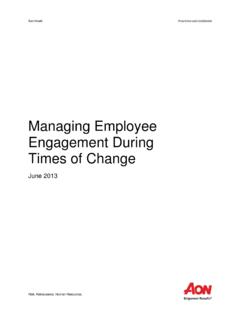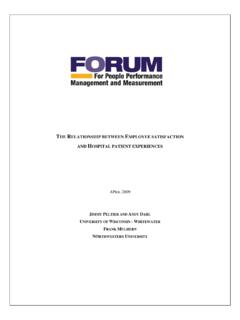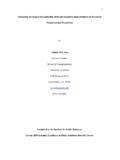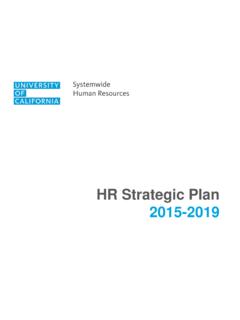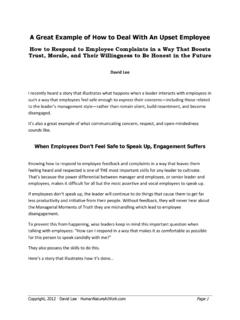Transcription of RELATIONSHIP BETWEEN EMPLOYEE …
1 RELATIONSHIP BETWEEN EMPLOYEE engagement AND commitment IN BARCLAYS BANK OF KENYA BY JOY M. WACHIRA A RESEARCH PROJECT SUBMITTED IN PARTIAL FULFILLMENT FOR THE AWARD OF THE DEGREE OF MASTER OF BUSINESS ADMINISTRATION (MBA), SCHOOL OF BUSINESS, UNIVERSITY OF NAIROBI. SEPTEMBER, 2013 i DECLARATION I, the undersigned, declare that this project is my original work and that it has not been presented in any other university or institution for academic credit. Full Name: JOY M. WACHIRA REG NO: D61/8882/2005 SUPERVISOR: This project has been submitted for examination with my approval as university supervisor. FLORENCE K. MUINDI SCHOOL OF BUSINESS UNIVERSITY OF NAIROBI ii ACKNOWLEDGEMENTS I would like to take this opportunity to thank God for without him, I would not be where I am would also like to thank my husband Sailepu, whose consistent encouragement, tolerance and support enabled me complete the project within the set time frame.
2 Iii DEDICATION I dedicate my project to all human resource practitioners. May the findings of this research be of use to current and future practice. iv TABLE OF CONTENTS DECLARATION .. i ACKNOWLEDGEMENTS .. ii DEDICATION .. iii TABLE OF CONTENTS .. iv ABSTRACT .. vii CHAPTER ONE: INTRODUCTION .. 1 Background of the Study .. 1 Research Problem .. 6 Objective of the Study .. 8 Value of the Study .. 9 CHAPTER TWO: LITERATURE REVIEW .. 10 Introduction .. 10 EMPLOYEE engagement .. 10 EMPLOYEE 15 RELATIONSHIP BETWEEN EMPLOYEE engagement and EMPLOYEE commitment .. 18 CHAPTER THREE: RESEARCH METHODOLOGY .. 23 Introduction .. 23 Research Design .. 23 23 Sampling Design .. 23 Data Collection .. 24 Data Analysis .. 24 CHAPTER FOUR: DATA ANALYSIS, RESULTS AND DISCUSSION .. 26 Introduction .. 26 Response Rate .. 26 General Information .. 26 EMPLOYEE engagement .. 30 v EMPLOYEE 34 RELATIONSHIP BETWEEN EMPLOYEE engagement and EMPLOYEE commitment .
3 38 CHAPTER FIVE: SUMMARY, CONCLUSION AND RECOMMENDATIONS .. 40 Introduction .. 40 Summary of Findings .. 40 Conclusions .. 42 Recommendations .. 43 Recommendations for Further Research .. 44 REFERENCES .. 45 APPENDIX .. 51 Appendix I: Questionnaire .. 51 vi LIST OF TABLES Table : Sample Size 24 Table : Gender of the Respondents 27 Table : Position in the organization 27 Table : Length of Service 28 Table : Respondent s Department 29 Table : Respondent s Educational Qualifications 29 Table : The Extent of EMPLOYEE engagement 31 Table : Statements on EMPLOYEE commitment 35 Table : Correlations 38 vii ABSTRACT Employees who are engaged in their work and committed to their organizations give companies crucial competitive advantages including higher productivity and lower EMPLOYEE turnover.
4 This research investigated the RELATIONSHIP BETWEEN EMPLOYEE engagement and EMPLOYEE commitment to the organization. The objective of the study was to establish the RELATIONSHIP BETWEEN EMPLOYEE engagement and EMPLOYEE commitment at Barclays Bank of study adopted a descriptive survey design in the investigation of the RELATIONSHIP BETWEEN EMPLOYEE engagement and EMPLOYEE commitment at Barclays Bank of Kenya. Stratified sampling technique was used to select the sample after which simple random sampling was used to select 175 respondents from the organisation. The study used both primary and secondary data. From the study it is evident that reward, adequate remuneration by the employer and recognition would work towards building of trust BETWEEN employees and management. The organization encouraged sharing of information, knowledge and resources; and provided opportunities for employees to learn and grow thus influencing EMPLOYEE engagement and overall engagement policy framework to a great extent.
5 EMPLOYEE commitment is evidenced by good reward and salary programs, approaches that show interest in EMPLOYEE career development. It can be concluded that the allowing people to make their own decisions about work, to control their work, and to achieve their goals may help employees become more engaged in their jobs. Further to this it is recommended that managers within organizations involve employees more in setting goals. Organizations also need to formulate ways of recognition of contribution by employees that would help define what determines EMPLOYEE engagement in order to enhance commitment levels. 1 CHAPTER ONE: INTRODUCTION Background of the Study Given the economic volatility we anticipated in 2012, EMPLOYEE engagement is critical arguably more so than in more normal conditions. For large multinational employers operating in multiple regions, this means a one-size-fits-all strategy for engagement across the globe will not work.
6 The EMPLOYEE engagement dynamics and resultant human capital interventions and outcomes may vary significantly depending on the industry or region of the model in which you operate. Regardless, one thing is certain employees and their behavior is at the center of business success (or failure). Ensuring that employees invest discretionary effort in the right behaviors will be critical in delivering the business results needed in conditions of recession, stagnation, or rapid growth (Bockerman and Ilmakunnas, 2012). Organizations with an inculcated EMPLOYEE engagement philosophy within their work environment naturally become counted as best companies to work for since people are put at the heart of the corporate purpose (Gratton, 2000). It is for this reason that organizations spend, or should spend, a considerable amount of time in building the capacity and capability of their employees.
7 Such investment would then contribute to the overall performance of the organization. It has been well documented through various theories (Maslow s, Hertzberg, etc) that motivation is a key driver to the performance of an EMPLOYEE . Both these theories contend that human beings have needs, and the more those needs are satisfied, the better an EMPLOYEE would perform. Such performance would also be affected by training and development, job security, organizational structure and compensation (Gratton, 2000). 2 commitment manifests itself in distinct behavior. commitment also has an emotional component. People usually experience and express positive feelings toward an entity or individual to whom they have made a commitment . commitment also has a rational element. Most people consciously decide to make commitments, then they thoughtfully plan and carry out the actions required to fulfill them.
8 As commitments require an investment of time as well as mental and emotional energy, most people make them with the expectation of reciprocation. Employees and employers have traditionally made a tacit agreement. In exchange for workers commitment , organizations would provide forms of value for employees, such as secure jobs and fair compensation. Reciprocity affects the intensity of a commitment . When an entity or individual to whom someone has made a commitment fails to come through with the expected exchange, the commitment erodes (Cohen, 2003). Nevertheless, some organizations have year after year made a concerted effort to address EMPLOYEE commitment and engagement issues and as always, successes have varied from organization to organization (Wellins, Bernthal and Phelps, 2005). It takes little persuasion on a theoretical level to convince a business leader, that employees who are more committed or engaged, work harder and smarter, and will be better for the company than those who turn up and do merely what they are obliged to do (Gallup Research Report, 2003).
9 EMPLOYEE engagement EMPLOYEE engagement is the positive attitude held by the EMPLOYEE toward the organization and its values. An engaged EMPLOYEE is aware of business context, and works with colleagues to improve performance within the job for the benefit of the organization (Robinson, Perryman, and Hayday, 2004). Maslach et al (2001) view 3 EMPLOYEE engagement as a concept with a sparse and diverse theoretical and empirical demonstrated relevance to the RELATIONSHIP among potential antecedents and consequence of engagement as well as the components of engagement have of engagement have not been rigorously conceptualize, much less studied. Macey and Schneider (2010) state that engagement is the illusive force that motivates employees to higher (or lower) levels of performance. They contend that EMPLOYEE engagement is a desirable condition that has an organization purpose and connotes involvement.
10 It is the commitment passion, enthusiasm, focused effort and energy so that it has both attitudinal and behavioral component. Doherty (2010) states that engagement is about respect going up, down and across a business. It also relates to alignment of HR and management policies to business culture and objectives. Simpson (2009), who is the researcher about engagement in USA hospitals, said EMPLOYEE engagement , is about EMPLOYEE performance (related with nurse performance, patient outcomes and other core healthcare organizational outcomes) at work within organizational performance based. Melcrum (2005) defines EMPLOYEE engagement as composing of three areas which are think, act, feel. Think which is cognitive commitment describes an EMPLOYEE s intellectual connection with the company, including their support and belief in the company s objectives.


